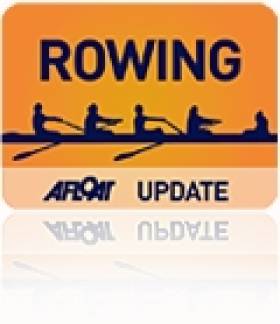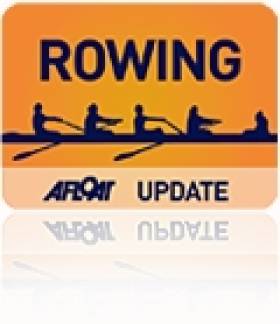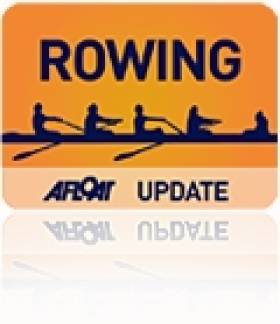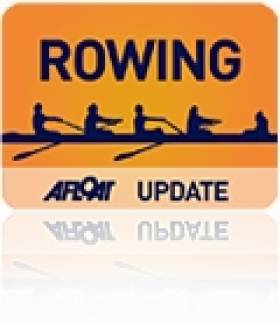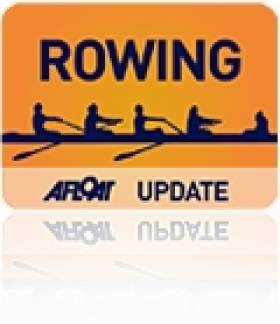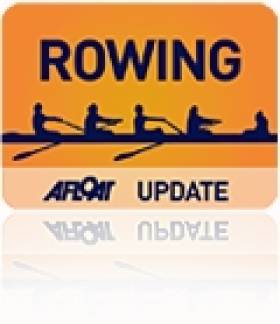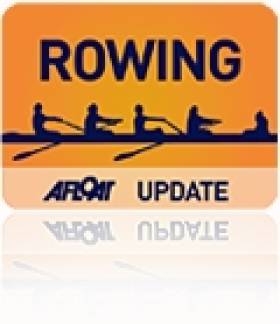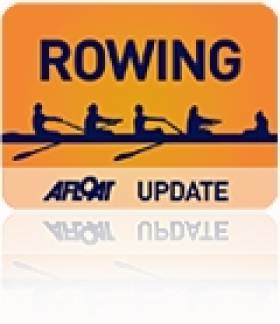Displaying items by tag: Ireland,
# ROWING: Ireland’s two men’s crews at the World Under-23 Championships in Lithuania could not force their way into the top three in their semi-finals and will compete in B Finals tomorrow. The lightweight pair of Jonny Mitchell and Shane O’Donovan finished fourth in a fast race and the open weight four were fifth, off the pace in the second half of their semi-final.
World Under-23 Rowing Championships, Day Three (Irish interest)
Men
Four – Semi-Final One (First Three To A Final; rest to B Final): 1 Germany 6:07.72, 2 Australia 6:09.42, 3 United States 6:11.14; 4 Canada 6:15.15, 5 Ireland (E Mullarkey, S O’Connor, F Manning, T Lynam) 6:24.15, 6 Ukraine 6:25.91
Lightweight Pair – Semi-Final One (First Three To A Final; rest to B Final): 1 Italy 6:57.34, 2 Germany 7:00.08, 3 Hong Kong 7:00.45; 4 Ireland 7:13.55, 5 Lithuania 7:24.78, 6 United States 7:29.70.
Women
Lightweight Single Scull – Repechage Three (First Two to A/B Semi-Finals): 1 Ireland (C Lambe) 8:19.32, 2 Israel 8:23.22; 3 Czech Republic 8:28.19, 4 United States 8:35.35.
# ROWING: Claire Lambe won her repechage at the World Under-23 Rowing Championships in Lithuania to become the fifth of the five Ireland crews to qualify for the A/B semi-finals. The Dubliner led down the course and had almost four seconds to spare over Chen Oshri of Israel, who also qualified.
World Under-23 Rowing Championships, Day Three (Irish interest)
Women
Lightweight Single Scull – Repechage Three (First Two to A/B Semi-Finals): 1 Ireland (C Lambe) 8:19.32, 2 Israel 8:23.22; 3 Czech Republic 8:28.19, 4 United States 8:35.35.
Ireland Under-23 Pair and Four Make World Rowing Semi-Finals
# ROWING: Two more Ireland boats moved into the semi-finals of the World Under-23 Rowing Championships in Trakai in Lithuania today. The lightweight pair of Jonny Mitchell and Shane O’Driscoll won their repechage by leading virtually all the way, while the men’s four came close to matching the feat, finishing second. They won a battle with Norway but were pipped by Ukraine, who mounted a surprise late charge, having been in third for much of the 2,000 metres. All three crews qualified.
World Under-23 Championships, Trakai, Lithuania, Day Two (Irish interest)
Men
Four – Repechage (First Three to A/B Semi-Final): 1 Ukraine 6:12.88, 2 Ireland (E Mullarkey, S O’Connor, F Manning, T Lynam) 6:16.64, 3 Norway 6:18.89; 4 Lithuania 6:24.74.
Lightweight Pair – Repechage (First Three to A/B Semi-Final): Ireland (S O’Driscoll, J Mitchell) 6:51.24, 2 Switzerland 6:51.89, 3 Lithuania 6:55.97; 4 Croatia 7:03.13
Women
Double Scull – Heat Three (First Three directly to A/B Semi-Final; rest to repechage): 1 Austria (M Lobnig, L Farthofer) 7:24.99, 2 France 7:29.62, Ireland (L D’Urso, H Nixon) 7:31.90; 4 Romania 7:42.91, 5 Croatia 7:47.31
Single Scull – Heat One (First Two Directly to A/B Semi-Final; rest to repechage): 1 Denmark (R Quist) 7:49.16, 2 Ireland (L Dilleen) 7:54.72; 3 United States 7:59.12, 4 Belgium 8:05.15, 5 France 8:08.88.
Lightweight Single Scull – Heat One (First directly to A/B Semi-Final, rest to repechage): 1 Cyprus (A Ioannou) 8:07.34, 2 Ireland (C Lambe) 8:12.84.
# ROWING: The Ireland double of Laura D’Urso and Holly Nixon qualified for the semi-finals of the World Under-23 Championships by finishing third in their heat this morning in Trakai in Lithuania. The Irish chased eventual winners Austria down the course, and filled second until a late challenge by France pushed them into third.
Claire Lambe must compete in a repechage after finishing second in a fight for the one qualification place with Anna Ioannou of Cyprus in their heat of the lightweight single scull. The Dubliner refused to let Ioannou get comfortable in the lead and passed her going into the final quarter, but the Cypriot struck back and retook the lead.
World Under-23 Championships, Trakai, Lithuania, Day Two (Irish interest)
Women
Double Scull – Heat Three (First Three directly to A/B Semi-Final; rest to repechage): 1 Austria (M Lobnig, L Farthofer) 7:24.99, 2 France 7:29.62, Ireland (L D’Urso, H Nixon) 7:31.90; 4 Romania 7:42.91, 5 Croatia 7:47.31
Lightweight Single Scull – Heat One (First directly to A/B Semi-Final, rest to repechage): 1 Cyprus (A Ioannou) 8:07.34, 2 Ireland (C Lambe) 8:12.84.
# ROWING: Ireland’s lightweight pair of Shane O’Driscoll and Jonathan Mitchell came within a third of a second of direct qualification for the semi-finals at the World Under-23 Rowing Championships in Trakai in Lithuania today. In a close finish to a competitive heat, Argentina pipped them for the third qualification place. The Ireland men’s four also finished fourth in their heat and will join the pair in tomorrow’s repechages. Both crews should make it through, as three crews qualify from a line-up of four in both repechages.
World Under-23 Championships, Trakai, Lithuania, Day One (Irish interest)
Men
Four – Heat One (First Three to A/B Semi-Finals, rest to Repechage): 4 Ireland (E Mullarkey, S O’Connor, F Manning, T Lynam) 6:20.49.
Lightweight Pair – Heat One (First Three to A/B Semi-Finals, rest to Repechage): 4 Ireland (S O’Driscoll, J Mitchell) 6:58.62.
# ROWING: A tremendous performance by a crew including three lightweights won lots of praise but was not enough to see the UCC/London Rowing Club progress in the Queen Mother for open quadruple sculls at Henley Royal Regatta this morning. The headwind conditions did not suit the crew of Rowing Ireland lightweights Niall Kenny, Anthony English, Mark O’Donovan and English heavyweigt Henry Pelly, but they got off to a great start and headed Canadian opponents Victoria City. Even when passed, the men in green came back at their bigger rivals and drew level.The Canadian crew then establised a lead but could not break away until a push in the last 10 to 15 strokes which saw them win by one and three-quarter lengths.
Victoria City were surpise winners on Friday against Danmarks Rocenter, a selected (seeded) crew.
Henley Royal Regatta, Day Four (Irish interest):
Queen Mother (Quadruple Sculls, Open): Victoria City Rowing Club, Canada bt UCC/London RC (N Kenny, A English, H Pelly, M O’Donovan) 1¾ l, 7:24
# ROWING: Sanita Puspure won in her first outing at Henley Royal Regatta today. The Cork-based athlete beat Pippa Whittaker, a Nottingham oarswoman, in the Princess Royal for single sculls. The British under-23 hopeful started well but Puspure took control and established a good lead. The eventual margin of victory was given as ‘easily’.
Adam Boreman, who has come through from the Ireland Talent ID programme, and Chris Beck of RBAI teamed up in the Double Sculls, an open event, but were beaten by a big margin.
Henley Royal Regatta, Day Three (Irish interest)
Princess Royal (Single Sculls, Women, Open): S Puspure (Old Collegians) bt P Whittaker (Nottingham) easily, 10.31
The Double Sculls (Open): SH Whelpley and WS Cowles bt A Boreman (Belfast Boat Club) and C Beck (RBAI) easily, 8:45.
Rob Roy End Cork's Run at Henley Royal Regatta
# ROWING: The Cork Boat Club four of John Paul Collins, Stephen Carroll, Colm Dowling and Shane Mac Eoin put in a good challenge in the second round of the Wyfold Cup but could not overcome Rob Roy from Cambridge at Henley Royal Regatta. The English crew led by half a length at the quarter mile and held off Cork’s pushes to extend their lead.
Colin Williamson of Queen’s University lost to El Salvador’s Roberto Lopez in the Diamond Sculls. Lopez powered away from Williamson early on and did not yield up the advantage.
Henley Royal Regatta, Day Two (Irish interest)
Wyfold Cup (Fours, Club): Rob Roy bt Cork BC 4¼ l, 7:53
Diamond Sculls (Single Sculls, Open): R Lopez (El Salvador) bt C Williamson (Queen’s University) easily, 9:00
# ROWING: Ireland’s only eight competing at Henley Royal Regatta bowed out of the Temple Cup today. Trinity led the University of Michigan at the Barrier and Fawley (roughly halfway). A push by Trinity was ineffective, but the Americans staged their own which took them into the lead. They took control and won by one and a quarter lengths.
Henley Royal Regatta, Day One (Irish interest)
Temple Cup (Eights, Student): University of Michigan (USA) bt Trinity 1 ¼ l, 7:12
Prince Albert Cup (Coxed Fours, Student): Imperial College bt Queen’s University 1¾ l, 8:07
Wyfold Cup (Fours, Club): Cork BC bt Cardiff City 1l, 7:52; Rob Roy bt Henley B 4l, 7:56
Ireland Junior Rowing Team for World Championships Chosen
# ROWING; Four Ireland crews have been chosen to represent Ireland at junior level at the World Senior and Junior Championships in Plovdiv in Bulgaria in August. The men's single of Paul O'Donovan and the pair of Joel Cassells and Chris Black will be joined by Kate O'Brien in the junior women's single and a junior women's quadruple. The teams for the Coupe de la Jeunesse and the Home Internationals have also been picked.
| JUNIOR TEAMS |
|---|
| JUNIOR WORLD ROWING CHAMPIONSHIPS – PLOVDIV, BULGARIA |
| JM1X Paul O’Donovan (Skibbereen RC) |
| Coach: Teddy O’Donovan |
| JW 1x Kate O’Brien (St.Michael’s RC) |
| Coach : HP Team |
| JM2‐ Joel Cassells (Bann RC) |
| Chris Black (Bann RC) |
| Coach: Seamus Reynolds |
| JW4X‐ Bridget Jacques (Belfast Boat Club) |
| Hilary Shinnick (Fermoy RC) |
| Katie Cromie (Portora BC) |
| Bernadette Walsh (Skibbereen RC ) |
| Coaches: Derek Holland , Nathan Adams |
| Team Manager: Martin McElroy |
| Lead Coach : Derek Holland |
| Details regarding the Junior World Rowing Championships can be found at |
| http://www.worldrowing.com/events/2012‐world‐rowing‐senior‐and‐juniorchampionships |
| COUPE DE LA JEUNESSE – BANYOLES, SPAIN |
| JM4‐ Henry Millar (Portora BC) |
| Lloyd Seaman (Portora BC) |
| Finnion Tolan (St. Joseph’s RC) |
| James Egan (St. Joseph’s RC) |
| Coaches: Derek Holland , David Ewart |
| JM2X Andrew Griffin (Neptune RC) |
| David Quinlan (Castleconnell BC) |
| Coaches: John Holland |
| JM4X Aodhan Burns (Skibbereen RC) |
| John Mitchell (Lee RC) |
| Jack Casey (Shandon BC) |
| Paddy Hegarty (Skibbereen RC) |
| Coaches: John Holland , Teddy O’Donovan |
| JW4x Aileen Crowley (Muckross RC) |
| Lucie Litvack (Belfast Boat Club) |
| Sarah Allen (Bann RC) |
| Sarah Higgins (Cork BC) |
| Coach: Nathan Adams |
| JW2‐ Brooke Edgar (Bann RC) |
| Aoife Cooper (Muckross RC) |
| Coach: Seamus Reynolds |
| Team Manager: Clare Cox |
| Lead Coach: Derek Holland |
| Details regarding the Coupe de la Jeunesse can be found at |
| http://www.cebanyoles.cat/en‐us/competicio/rem2012/inici.aspx |
| http://www.couperowing.org/ |
| HOME COUNTRIES REGATTA |
| JM4‐ / JM 8+ William Yeomans (Commercial RC) |
| Colm O’Riada (Commercial RC) |
| Gary Thornton (Portora BC) |
| Chris Alcorn (Bann RC) |
| JM4+/ JM8+ Eric McEvoy (St.Josephs RC) |
| Aiden Kinneen (St.Josephs RC) |
| Kevin Keohane (Presentation College) |
| Niall Crowley (Presentation College) |
| JM2‐ Shane Walsh (Galway RC) |
| Alan Murtagh (Galway RC) |
| Colm Connelly – Cox (St. Joseph’s RC) |
| Coaches: John Walsh, Jamie Bradley |
| JM4X‐ Matthew Ryan (Skibbereen RC) |
| Andy Harrington (Shandon RC) |
| Daniel Buckley (Lee RC) |
| Paudie Leonard (Skibbereen RC) |
| Coach : David O’Donovan |
| JM2X Andrew Bell (Colaiste Iognaid) |
| Patrick Boomer (Methodist College ) |
| JM1X David O’Malley (St.Michaels’s RC) |
| Coach: James Boomer |
| JW4‐ / JW8+ Ruth Gilligan (Shannon RC) |
| Lauren McHugh (Shannon RC) |
| Ruth Cummins (Galway RC) |
| Kellie Wade (Galway RC) |
| JW4+ / JW8+ Hanna McCarthy (St.Michael’s RC) |
| Hanna O’Sullivan (St.Michael’s RC) |
| Emily Hutchinson (Bann RC) |
| Fiona Murtagh (Galway RC) |
| JW2‐ Kara O’Connor (Muckross RC) |
| Jasmine English (Methodist College) |
| Affric O’Regan Cox (Galway RC) |
| Coach: Iain Cumiskey, Michael O’Callaghan |
| JW 4x Leonie Hamel (Cork BC) |
| Megan McLaughlin (Cork BC) |
| Rosin Merz (Shandon RC) |
| Laura Coleman (Shandon BC) |
| Coach: David O’Donovan |
| JW 2x Kathrine Cremin (Muckross RC) |
| Sadbh Cassidy (Neptune RC) |
| JW 1x Ella Ciallis (Skibbereen RC) |
| Coach: Cathal Moynihan |
| Team manager: Lisa O’Callaghan |


























